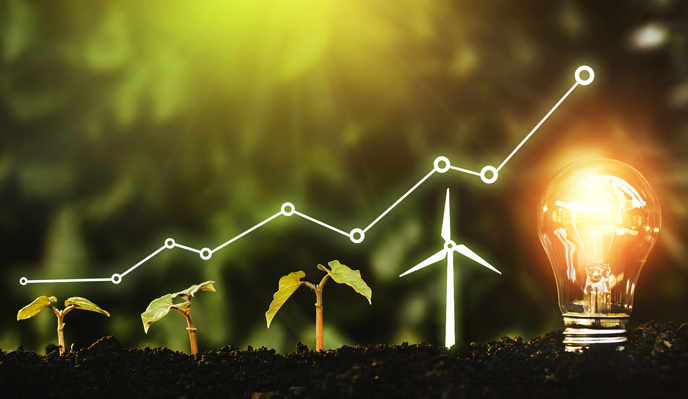Kenya’s path to becoming a Green Economy: How this can be achieved?

BY: Aarti Krishnan
The seventh annual Devolution Conference under the theme: Multi-level governance for climate action, has just ended in the beautiful county of Makueni.
Delegates at the conference, including public and private sector players, were all out engaging on climate change and exploring the avenues on sub-national mobilisation of resources in unlocking the full potential of climate action during and after pandemics.
By all means, this was an apt topic for high-level engagement and one that fits in well with climate change and adaptation realities.
Undoubtedly, the looming climate emergency calls for countries to transition to a green economy. These transitions can take place through trading out and up, enabling firms and countries to upgrade (increase value added), whilst simultaneously attaining greener net zero value chains. However, this is a complex task in Kenya. Especially when the unfair global environmental governance policies (like Environmental Good Agreement 2014 and sustainability standards) marginalise participation of Kenya in global value chains.
Why green transitions are challenging for Kenya
Kenya’s participation in value chains is contingent on primary sectors such as natural resources and agriculture. On one hand, these sectors are associated with high environmental costs, such as falling water tables, degraded soil quality and reduced biodiversity. On the other hand, participation in these sectors often occurs upstream in the value chain, thereby engendering, low value addition. Low-value addition is exacerbated by non-trade barriers, such as imposing an array of standards from phytosanitary standards to private international supermarket standards in Europe and the US, to voluntary sustainability standards (e.g. Fairtrade, GlobalGAP) on Kenyan suppliers. For example, research at the University of Manchester shows that farmers exporting avocados and beans are squeezed due to high compliance costs, which outweigh the socio-economic-environmental benefits, in some cases leaving them in debt. Additionally, the introduction and expansion of other instruments such as carbon border adjustments, target several primary sectors, which adds to the precarity of Kenya’s participation.
How Kenya has been excluded from global environmental decision making
Kenya’s voice is lacking in one of the most important global policies, the Environmental Goods Agreement (EGA), launched in 2014 by the World Trade Organization (WTO). EGA aims to create tariff free trade, thereby incentivizing green exports. The list of environmental goods has been expanded into a universal list of about 408 goods (WTO 2011), but what products are included, and what/how liberalisation structures are implemented, is skewed towards 46 high and middle-income countries who participated in the WTO negotiations. Furthermore, EGA does not include standards, which are by far the key trade barrier that affects Kenya’s exports. This means the goods part of EGA has an inclusionary bias.
Environmental goods should Kenya consider: Cash cows and sunrise products
One of the most powerful ways to understand green competitiveness is through unpacking the revealed comparative advantage (RCA). RCA is when a country exports more than its fair share with respect to the exports from the rest of the world. The RCA for Kenya is computed yearly between 2016-2020. If Kenya has an RCA every year between 2016-2020, then the product is considered a ‘cash cow’ i.e. a major strength for the country; and if Kenya has had an RCA 3-4 times between 2016-2020, it is considered a ‘sunrise product’ i.e. with potential to expanding exports.
The results in table 1 indicate that Kenya has 300 cash cow products where they have competitive advantage compared to the rest of the world, which totals up to about 13% of Kenya’s total trade. These primarily include roasted coffee, fresh vegetables, beets, molasses, fish, and tea etc. These products are special niches for Kenya, where they are ahead of most of the world. The second category are sunrise products (108) which total to about 1% of trade, these products have potential to expand and turn into cash cows for Kenya. Some examples include meat, fish, foliage, rare gases, and chemicals. However, not a single one of these appears on the list of the 408 WTO universal list of products under EGA.
Table 1: Products where Kenya has a competitive advantage
| Total no. of products traded | Total Value of Trade ‘000s (2020) | No. of products (Cash Cows) | Value of Cash Cows ‘000s (2020) | Cash Cows % of total trade | No of products (Sunrise) | Value of Sunrise ‘000s
(2020) |
Sunrise as a % of total trade |
| 4980 | 6023442 | 300 | 797833 | 13.3% | 108 | 59503 | 1% |
While many of these products fall under preferential trade agreements such as Generalised Scheme of Preferences and African Growth Opportunities Act, allowing for tariff free trade reduces non-tariff barriers of standards. Overarchingly, this means for Kenya to transition to a greener economy: there is a need to (a) reduce non-trade barriers on environmental goods to facilitate trade by decreasing the cost of environmental technologies (and therefore investments) (b) to include primary goods within definitions of environmental goods, where Kenya has competitive advantage.
How best to achieve green transitions
To leverage green competitive advantages, Kenya can attempt to ‘retrofit’ cash cow product value chains. Retrofitting involves investing in specific tasks for adding environmental value (greening value chains). As comparative advantage already exists, investments in environmental technologies and production capabilities can engender upgrading possibilities. But to ensure inclusivity, there is a need for a coordinated effort across government, civil society and the private sector to create equitable industrial policies that not only promote exports, but also complement social-environmental policies to support vulnerable actor livelihoods and protect nature. On the other hand, to develop sunrise products further, value chains can be ‘born clean’, this means governments and the private sector should invest using best available technology and practices at the get-go. Therefore, sunrise products start out ‘green’ and hence provide prospects for Kenya to leapfrog.
About the Author: Ms Aarti Krishnan, is a Hallsworth Research Fellow at the University of Manchester. Email: aarti.krishnan-2@manchester.ac.uk

